A lot of RPG adventures are set in villages. Today, I’ve got a real-world Medieval village that’s just screaming to be fictionalized and dropped into your campaign setting. As you’ll see, it’s got loads of baked-in plot hooks that transcend the Medieval genre! This is the village of Montaillou, in what is today France, in the foothills of the eastern end of the Pyrenees (near the border with Spain). And around the year 1300 (or a little after), Montaillou was a hotbed of intrigue. Despite having a population of only 200, Montaillou lay at this amazing crossroads of heresy, inquisition, political rivalry, and personal drama that affected everything that happened there. And thanks to a remarkable source, we get a front-row seat to all of it!
This post is brought to you by beloved Patreon backer Colin Wixted. Thanks for helping keep the lights on! If you want to help keep this blog going alongside Colin, head over to the Patreon page – and thank you!
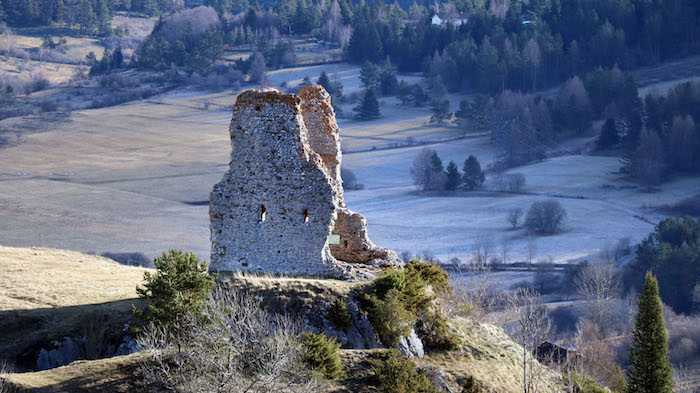
Image credit: Jcb-caz-11. Released under a CC BY-SA 4.0 license.
Repeating myself from an earlier post, in the Middle Ages, the greater region Montaillou fell in was synonymous with the heresy of Catharism. Cathars believed there were two gods: one good, who created souls and heaven, and one evil, who created the world and all that’s in it. Death was a brief stopover in an endless cycle of rebirth in a sinful, suffering world. From 1209-1229, the Catholic Church fought a crusade to stamp out Catharism. Hundreds of thousands of Cathars died. For a hundred years after, a Catholic inquisition remained in the area to root out secret Cathars living in the countryside.
Of particular interest is the Cathar priesthood: the Perfects. Perfects underwent a ceremony called the consolamentum (‘hereticization’ to the Church) and were made free from sin. To then retain that status, Perfects had to abide by stringent restrictions, most notably committing to vegetarianism and chastity. The chief job of the Perfects was to perform the consolamentum for dying Cathar lay people. When you were about to die, you sent for a Perfect who performed the ceremony for you. You then lay in your sickbed and refused to eat until you starved to death. This was the only way to die sinless, and thus escape the eternal cycle of rebirth.
We’re interested here in the tiny village of Montaillou. Catharism could no longer be practiced openly, but many of the old folks were still diehard Cathars. Their children and grandchildren held muddled pseudo-Cathar beliefs. This was a devolved form of the religion. When your faith is no longer passed on by books and sermons, but by furtive fireside conversations, your theology suffers in the retelling. It used to be both men and women could be Perfects, but by 1300-ish, women were barred from Perfect-hood, and were now seen as so impure that even with a deathbed consolamentum, they might have to hope to be reborn as men to have a chance at escaping reincarnation. Without the ceremony, of course, they’d probably join the wicked souls reborn as animals and have to gradually work their way back up to humanity and a shot at escape.
(Note that the study of Catharism is undergoing a bit of a shift right now. Consensus about some of the finer details of the faith may change in the next few years. The material above seems pretty safe, though.)
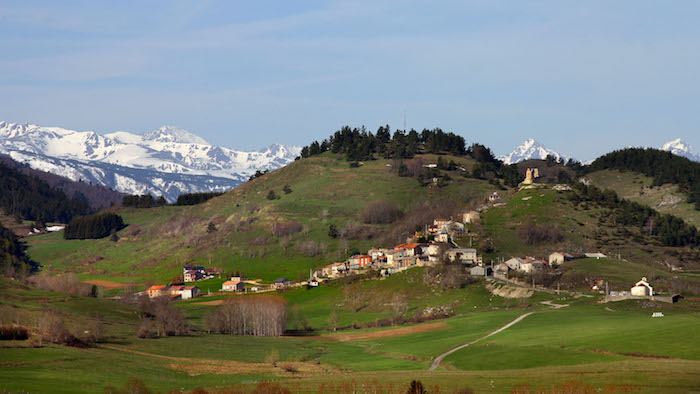
Image credit: Jcb-caz-11. Released under a CC BY-SA 4.0 license.
The layout of the village was awfully gameable. At the top of a hill, there was a small castle. Below it was the village of Montaillou proper, about 40 houses in all. All but three were one-story. The houses clung to the hillside so they could overlook one another. Many shared walls, effectively becoming single buildings. For this reason, Montaillou presented an imposing facade with few ways in or out, and multiple tiers of roofs staring down at the viewer. The village was not fortified, but it was hard enough to get into that during an attack, the villagers could escape up the hill to the castle. Not that there was much risk of an attack – the region didn’t suffer the constant warfare the Spanish lords practiced on the other side of the Pyrenees. The other effect of these interconnected buildings was that the village was full of secret passages. If the Lizier and Belot households shared a wall, there might be a secret door between them. In the darkness of these cramped houses, you’d never know unless one of them invited you in and showed you. This was one way the more ardently Cathar families maintained their relationships without flaunting their association publicly.
The area around Montaillou is also relevant. Below the village was the church. Below that was the cemetery, which surrounded a chapel dedicated to the Virgin Mary, who was sacred to both Catholics and Cathars. And all around that was a checkerboard of gardens and fields worked by the villagers. Beyond that were the pastures where wild, itinerant shepherds kept their flocks. These shepherds were almost all male and unmarried. They came and went as they pleased, traveling all over the Pyrenees to find work. Thus, the shepherds were the best-informed people around Montaillou. They maintained networks of contacts around and across the mountains, and could even transmit information from valley to valley with specialized whoops. Above the pastures were forests and caves, home to wolves and Perfects.
Montaillou houses were built around a kitchen with an open hearth at the center. The kitchen was also dining room and living room: everything happened here. Around the kitchen were smaller personal rooms for one to two adults apiece – though at least one wall of the kitchen had to face outside, so it could have a window and let in a little light. Houses had flat roofs shingled with bits of wood. The wood wasn’t well-attached, so your neighbors could spy on you by lifting up a shingle with their head, then peering down into your house.
Folks in Montaillou were poor. Only three homes had a second story. There wasn’t a cart in the whole village. Nobody owned enough to need (or even afford) one. Even the ‘tavern’ brought its wine up from the lowlands by mule – not that the tavern had a building. Fabrisse Rives just went ‘round to people’s houses to sell them booze. Nor was there a blacksmith or a store. The priest didn’t live any better, nor did the castellan.
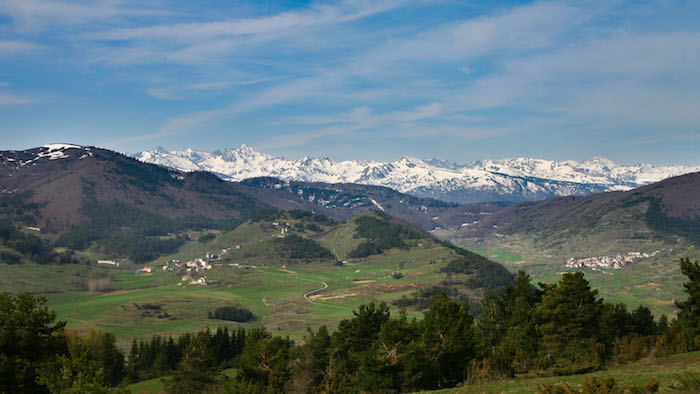
Image credit: Jcb-caz-11. Released under a CC BY-SA 4.0 license.
The political situation in Montaillou was full of surprises! First, the village wasn’t French. It belonged not to the Kingdom of France, but to the independent County of Foix. Admittedly, the once-powerful Counts of Foix had been reduced to dependency on France. Most of the anti-Cathar crusaders were French, and the Kingdom of France used the crusade as a pretext to annex many of Foix’s neighbors. If the Counts of Foix ever acted up, France would surely realize (conveniently) that Foix was insufficiently de-Catharized, invade, and annex Foix too. Still, Montaillou answered not to Paris, but to the court of Foix in Orthez.
And Montaillou answered directly to the Count – it had no local lord. While the Counts of Foix had many vassal lords with hereditary fiefs, Montaillou wasn’t part of any of them. If the village were part of a kingdom, we’d call it ‘crown lands’, but it wasn’t, so I’m not sure if there’s a word for what it was. There was a knight who lived in the castle and reminded the peasants he’d kill them if they rebelled. But this castellan was appointed to his position. It did not pass to his relatives after his death. He did not get to keep the taxes collected in Montaillou, nor did he have a household with fancy retainers. He was basically just a thug with a sword and a dungeon who lived in a damp, cold room in a castle. The castellan at the start of this period was a boring fellow named Bérenger de Roquefort. His wife, Beatrice de Planissoles, was much more interesting. She was also a minor noble but had Cathar sympathies: she was childhood friends with the Cathar Authié brothers (more on them in a bit). After her husband died and his assistant took over (an even more forgettable man named Jacques Alsen), Beatrice moved to an ordinary one-story house in Montaillou and started an affair with the village priest, Pierre Clergue (more on him too). She eventually succumbed to social pressure and moved away to marry another Catholic bore. Later in life, she enjoyed another affaire de cœur with a priest, and they were both hauled before the Inquisition.
The other representative of the Count of Foix was the bailiff. His job was to ensure taxes got collected and to arrest anyone who acted up. If he needed help chasing down a tax-evader or cracking skulls, he called upon the castellan. The bailiff was a peasant, Bernard Clergue, a local from Montaillou. His brother, Pierre Clergue, was the village priest. Even though Bernard was ostensibly responsible for arresting heretics and Pierre was responsible for educating away heresy, the Clergue brothers were themselves pseudo-Cathars! The Clergue family owned one of Montaillou’s three two-story houses and unofficially ran the village. We’ll dig into their business next week, because it is fascinating.
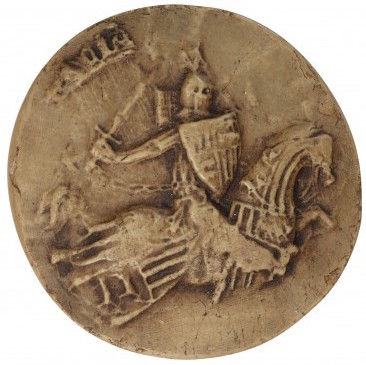
Image credit: Douet d’Arcq, Inventaire des Sceaux des Archives de l’Empire. Released under a CC BY-SA 4.0 license.
After the temporal powers – count, castellan, and bailiff – the next greatest power in Montaillou was that of the Church. Of course, their representative in the village, Pierre Clergue, was more Cathar than Catholic and did his best to keep the Church out of his business. Still, there were traveling priests and monks who sometimes stopped in Montaillou. In a fictional campaign setting, one can easily imagine a situation where a priest stops in the village and hears a woman is dying. Upon investigation, he discovers she’s not received Extreme Unction: the sacrament of ministering to the dying, which at the time involved feeding the subject the Eucharist. Instead, she’s received the consolamentum and is refusing all food. Is the Perfect who performed the ritual still in town? Can Pierre Clergue preserve his double life? It’s a political situation that’s likely to unfold explosively unless the PCs get involved.
The most dangerous arm of the Church around Montaillou was the Inquisition. In our time period, it was run by the Dominicans, a monastic order devoted to countering false belief. They were always happy to investigate when someone reported their neighbor for heresy. In a village like Montaillou, that was a pretty potent threat. Even if you weren’t a Cathar yourself (and most were, to some degree), you had loved ones – even dead loved ones – who would suffer if dragged before the tribunal. Folks had to be careful what they said and to whom. The walls could have ears, and you never knew when your neighbor might want to avenge herself upon you for some past wrong you committed. Plus, there was a persistent (though false) belief that you could avert your own inquisitorial disaster by reporting on your neighbors first. At its best, the Inquisition was an inconvenience. At its worst, Cathars could be sentenced to multi-year stints in the prison at Carcassonne, have their houses burned down, and receive up to a lifetime requirement to wear yellow crosses sewn into their clothes to mark them as penitent heretics. The rare Cathar who refused to repent was burned at the stake.
In opposition to the Church, we have the Perfects. There were two Perfects operating in the Montaillou area in and after 1300. They didn’t have settled homes, but bounced between Cathar households in different villages to stay one step ahead of the Inquisition. Both were pretty lousy Perfects, appropriate for the degraded last gasp of their religion. Prades Tavernier didn’t have much of a grasp on Cathar theology. He didn’t understand Latin, so he couldn’t read the Cathar holy books. Guillaume Belibaste had a better handle on the theology, but ignored it. He traveled with a female servant with whom he had frequent sex. He also enjoyed lecturing people about the evils of eating meat, even though only Perfects had to be vegetarians. Every once in a blue moon, Montaillou would host the Authié brothers who were Cathar missionaries, but it’s debatable whether they were Perfects. In any case, Guillaume Belibaste was burned by the Inquisition in 1321 and is generally held to be the last Cathar Perfect.
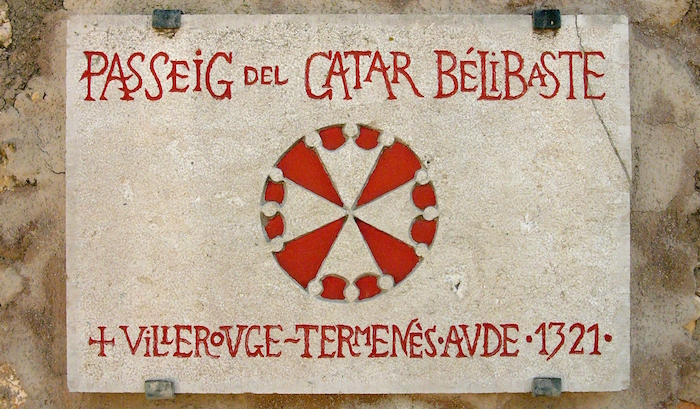
Image credit: Llapissera
So what do we have here? We have a village built like an anthill, where the buildings all connect to each other and everyone knows everyone else’s business. It’s also a village where neighbors report one another to the Inquisition to avenge past wrongs, where the few Catholic families scheme against the majority pseudo-Cathar families, where the family of a hypocritical priest is trying to set up its own secret mini-state, and where political power is both very local and very far away. It’s a village where wild migrating shepherds share news with traveling heretic priests, and where everyone – even the nobility – is desperately, achingly poor.
At your table, you’ll want to file the serial numbers off to make Montaillou fit your fictional campaign setting. Beyond that, this village legitimately fits anywhere. For example, are you running a space opera? Awesome, make Montaillou a space station and convert Catharism from a religious heresy to an unorthodox political belief. What’s important to hold on to is the feeling of paranoia (“Are my neighbors spying on me right now? Are they going to report me?”), political rivalry (“If the bailiff and the castellan disagree, whom do I support? What if it’s the analogues of the Count of Foix and the King of France?”), ideological warfare (“Which faith is better for this community and for our characters?”), and personal drama (“The priest is sleeping with who now?”).
And then you just run whatever you were going to run anyway, but set one or two of your adventures in this community. Tie elements of your adventure into this weird spy-infested anthill, and let the setting complicate the story. Doing a haunted house mystery? Great, the house is in Montaillou, and the Catholics and Cathars quietly blame each other for the haunting. How you handle the house will impact how both sides react to what you did. If you handle it in a way consistent with what the Cathars believe is going on and anger a few Catholics along the way, maybe you get reported to the Inquisition. Handle it in a way respectful of Catholic orthodoxy and maybe the Cathars start trying to smuggle haunted elements out of the house through a secret tunnel. And on and on!
Come back next week when we’ll talk about a vendetta between the Clergue family (of the priest and bailiff) and a poorer family. It’s a wild story!
Source: Montaillou: Cathars and Catholics in a French Village 1294-1324 by Emmanuel Le Roy Ladurie (1978)






